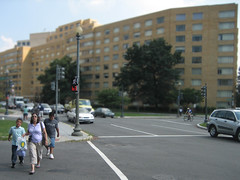Unbaffling yet another preservation story in the Washington Post
(Flickr photo of 1500 Massachusetts Ave. NW by Alexander Barth.)
Today's Post has a story about the expansion of the Dupont Circle Historic District, "Historic Status Baffles Building's Owners," subtitled "Designation Helps Expand 16th Street District."
The basic sentiment of the story is that the property owner of 1500 Massachusetts Avenue NW doesn't understand why his building has "architectural merit."
Below is something I wrote in Nov. 2005 in a blog entry, "Who can you turn to when the most active, aggressive destroyers of the city's livable places are DC Government agencies?" I guess I can send it into the Post, it's the same point.
---------------------------
I would argue that there are two basic levels of consideration for historic designation. One has to do with buildings of a high level of significance due to famous events and/or personages, i.e., George Washington slept here; Colden Florence designed it; Malcolm X was shot here; Rosa Parks made her stand here; John F. Kennedy had sex there; etc.
Criteria for Evaluation (from the National Register of Historic Places website)**
The quality of significance in American history, architecture, archeology, engineering, and culture is present in districts, sites, buildings, structures, and objects that possess integrity of location, design, setting, materials, workmanship, feeling, and association, and:
A. That are associated with events that have made a significant contribution to the broad patterns of our history; or
B. That are associated with the lives of persons significant in our past; or
C. That embody the distinctive characteristics of a type, period, or method of construction, or that represent the work of a master, or that possess high artistic values, or that represent a significant and distinguishable entity whose components may lack individual distinction; or
D. That have yielded or may be likely to yield, information important in prehistory or history.
** Usually Criterion C covers the creation of historic districts. The criteria used in DC are slightly different, but derive from the NR criteria.
The other is the preservation of the nexus of place, architecture, and social, cultural, and/or economic history. This as you know is the basic justification of the creation of neighborhood historic districts. The average building in such a district doesn't merit designation on its own. What matters is the power and beauty and coherence of the whole.This particular set of buildings is significant in terms of the second basic thrust.
---------------------------
In short this is about contributing buildings, and maintaining neighborhood character. If you look at the Code of Federal Regulations (36 CFR Part 60 - National Register of Historic Places), the examples provided shed a lot of light about the difference between National Landmarks, where the buildings are associated with specific people and/or architectural and social history, and Historic Districts, which have a different set of criteria.
The comments in the article, especially by the ANC commissioner, reflect a lack of knowledge about preservation, about the different standards of significance between national landmarks and historic districts, and about affordable housing (not necessarily a preservationist's issue, but one that all preservationists should be conversant with).
In my opinion, the owner is being disingenuous about designation being at odds with the objective of preserving affordable housing. If people want to preserve affordable housing, preservation is about the best strategy there is, especially in such a strong real estate market as DC, where the opportunity cost to preserve housing for people of lesser means is particularly high compared to the profits made serving higher income demographics. For a good discussion about this, I highly recommend the paper Affordable Housing and Historic Preservation: The Missed Connection, by Don Rypkema.
Were I in the same position as the owner, and only focused on maximizing return, I would choose to demolish the building and build something new and much more expensive.
This has happened west of the builidng on the 1600 block of Rhode Island, and east of the building on the 1400 block of Mass. Ave,. In addition, lower cost affordable buildings on the 1300 block of Mass Ave. have already been converted to higher end housing. (Didn't the Methodist senior citizens housing building also convert--on the south side of the 1300 block? I know the building immediately east of this building did convert to condos some time ago.)
Post Properties Mass Ave: 1499 Massachusetts Avenue, NW. Washington, DC 20005. Photo from the company website.
This popup listing of availability at the Post Properties building across the street from 1500 Massachusetts Avenue lists no apartment cheaper than $1,970/month, with the highest listed monthly rent of $6,485.
Affordable housing indeed.
Plus, the 20% federal historic tax credit for which the 1500 Massachusetts Avenue NW building is now eligible is another way to offset the slightly increased costs that an additional layer of regulation--justifiable to balance the rights of the property owner with the social value of land and community concern in maintaining neighborhoods and affordability.
It does illustrate the point that I make continually these days, that we (preservationists) need to develop a more strategic and consistent communications message about preservation generally and specifically.
Labels: historic preservation, housing




0 Comments:
Post a Comment
<< Home